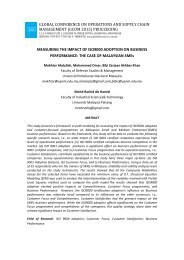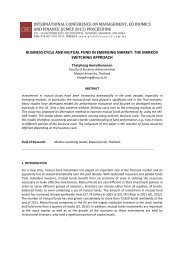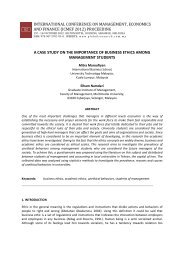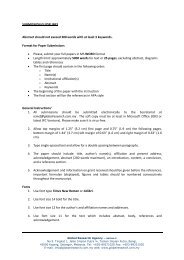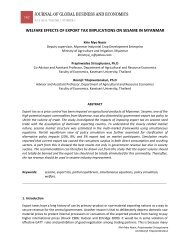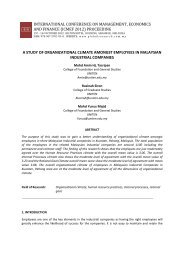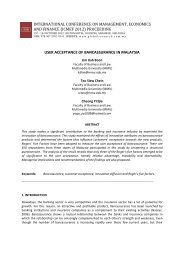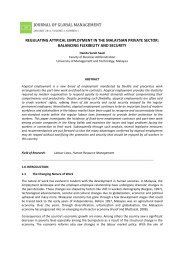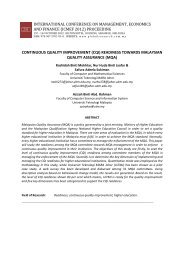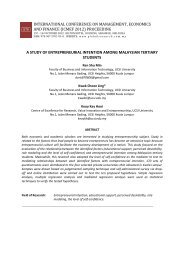The Success Factors of Food on Small Medium Entrepreneurs under
The Success Factors of Food on Small Medium Entrepreneurs under
The Success Factors of Food on Small Medium Entrepreneurs under
You also want an ePaper? Increase the reach of your titles
YUMPU automatically turns print PDFs into web optimized ePapers that Google loves.
44<br />
JOURNAL OF GLOBAL ENTREPRENEURSHIP<br />
JANUARY 2011. VOLUME 1. NUMBER 1<br />
THE SUCCESS FACTORS OF FOOD SMALL MEDIUM ENTREPRENEURS UNDER THE<br />
ONE DISTRICT ONE INDUSTRY PROGRAMME: A CASE ON FOOD<br />
MANUFACTURING ENTREPRENEURS IN MELAKA<br />
Othman Aman and Md. Nor Hayati Tahir<br />
Faculty <str<strong>on</strong>g>of</str<strong>on</strong>g> Technology Management and Technopreneurship<br />
Universiti Teknikal Malaysia Melaka, Malaysia<br />
othmanaman@mmu.edu.my<br />
Izaidin Abdul Majid, Nor Azah Abdul Aziz and Filda Rahmiati<br />
ABSTRACT<br />
<str<strong>on</strong>g>The</str<strong>on</strong>g> nurturing <str<strong>on</strong>g>of</str<strong>on</strong>g> <strong>Small</strong> and <strong>Medium</strong> sized Enterprises (SMEs) has been given a high priority in Malaysia<br />
and has been the backb<strong>on</strong>e <str<strong>on</strong>g>of</str<strong>on</strong>g> ec<strong>on</strong>omic growth. One <str<strong>on</strong>g>of</str<strong>on</strong>g> the Malaysia government initiatives to<br />
coordinate and m<strong>on</strong>itor the development <str<strong>on</strong>g>of</str<strong>on</strong>g> small medium enterprises is the One District One Industry<br />
(ODOI) Programme. <str<strong>on</strong>g>The</str<strong>on</strong>g> ODOI Programme is a strategic approach that can improve the wellbeing <str<strong>on</strong>g>of</str<strong>on</strong>g><br />
rural populati<strong>on</strong> in Malaysia. This research attempts to study the internal and external performance<br />
indicator for food manufacturing in small medium entrepreneurs <strong>under</strong> One District One Industry<br />
Programme in Melaka areas. A sample <str<strong>on</strong>g>of</str<strong>on</strong>g> 60 resp<strong>on</strong>dents <str<strong>on</strong>g>of</str<strong>on</strong>g> food manufacturing entrepreneurs was<br />
surveyed using a structured questi<strong>on</strong>naire. <str<strong>on</strong>g>The</str<strong>on</strong>g> result shows that entrepreneurial quality was the most<br />
internal factor, and Government policy was the most external factor. Lastly, the most dominant factor<br />
c<strong>on</strong>tributes to entrepreneurs’ performance is entrepreneurial quality. Recommendati<strong>on</strong>s explained to be<br />
useful and applicable for small medium entrepreneurs in Melaka. Government supports more to<br />
entrepreneurs in creating an ecosystem and knowledge based entrepreneurship for business incubati<strong>on</strong><br />
activities, and facilitate networking, c<strong>on</strong>necti<strong>on</strong> with pr<str<strong>on</strong>g>of</str<strong>on</strong>g>essi<strong>on</strong>al resources, and finally assist<br />
entrepreneurs in getting finances from venture capitalist, angle funding and other financing instituti<strong>on</strong>s<br />
are required.<br />
Keywords:<br />
SMEs, <strong>Entrepreneurs</strong>, <str<strong>on</strong>g>Success</str<strong>on</strong>g> <str<strong>on</strong>g>Factors</str<strong>on</strong>g>, <str<strong>on</strong>g>Food</str<strong>on</strong>g> Manufacturing, One District<br />
----------------------------------------------------------------------------------------------------------------------------------<br />
1.0 INTRODUCTION<br />
<str<strong>on</strong>g>The</str<strong>on</strong>g> development <str<strong>on</strong>g>of</str<strong>on</strong>g> the SME sector in Malaysia has been phenomenal, c<strong>on</strong>tributing significantly to the<br />
ec<strong>on</strong>omic growth process over the years (BNM, 2005). In spite <str<strong>on</strong>g>of</str<strong>on</strong>g> this sector’s c<strong>on</strong>tributi<strong>on</strong> to the<br />
ec<strong>on</strong>omy, there has been little effort to identify the impending challenges that SMEs face in <strong>under</strong>taking<br />
their business. Recogniti<strong>on</strong> <str<strong>on</strong>g>of</str<strong>on</strong>g> such challenges may assist both the government and industry players to<br />
take necessary acti<strong>on</strong>s to mitigate the identified problems and will eventually help the SMEs to escalate<br />
to greater heights.<br />
<str<strong>on</strong>g>The</str<strong>on</strong>g> Malaysian Government’s commitment to, and c<strong>on</strong>cern for, the development <str<strong>on</strong>g>of</str<strong>on</strong>g> SMEs has been<br />
clearly evident since early 1970s. <str<strong>on</strong>g>The</str<strong>on</strong>g> ‘New Ec<strong>on</strong>omic Policy’ was introduced in 1971, which aimed to<br />
improve people’s welfare and restructure ethnic ec<strong>on</strong>omic imbalances. <str<strong>on</strong>g>The</str<strong>on</strong>g> government’s commitment
45<br />
JOURNAL OF GLOBAL ENTREPRENEURSHIP<br />
JANUARY 2011. VOLUME 1. NUMBER 1<br />
to the development <str<strong>on</strong>g>of</str<strong>on</strong>g> SMEs can also be seen in the sec<strong>on</strong>d Industrial Master Plan (IMP2), which ended<br />
in 2005, which is followed by the Third Industrial Master Plan (IMP3) 2006 -2020 to coincide with the<br />
country’s visi<strong>on</strong> for 2020 (MITI,2005).<br />
SMEs have become increasingly aware <str<strong>on</strong>g>of</str<strong>on</strong>g> opportunities in the c<strong>on</strong>venience and halal food market, and<br />
str<strong>on</strong>g growth in the sector reflects this trend, which has been estimated at between US$150 billi<strong>on</strong> and<br />
US$200 billi<strong>on</strong> annually (SMIDP, 2002). Malaysia is well-positi<strong>on</strong>ed to capture such opportunities given<br />
its good standing in the Islamic world, together with the multi-ethnic cuisine. <str<strong>on</strong>g>The</str<strong>on</strong>g> halal and c<strong>on</strong>venience<br />
food sector also generates str<strong>on</strong>g intra-and inter industry linkages.<br />
Initiatives taken by the Malaysian government to boost rural income is the One-District-One-Industry<br />
(ODOI) progamme (Radiah Abdul Kader, et al., 2009). <str<strong>on</strong>g>The</str<strong>on</strong>g> One District One Industry Programme has<br />
been introduced by Malaysian Government to coordinate and m<strong>on</strong>itor the development <str<strong>on</strong>g>of</str<strong>on</strong>g> small<br />
medium enterprises including business development programme, training and entrepreneurs’<br />
development and products development as well as promoti<strong>on</strong> and sales.<br />
Based <strong>on</strong> the above literature review, there is little research about the success factors for <strong>Small</strong> and<br />
<strong>Medium</strong> Entrepreneur <strong>under</strong> the One District One Industry Programme which emphasis <strong>on</strong> case study<br />
<strong>on</strong> food manufacturing entrepreneurs in Melaka. This study will help to identify the determinants <str<strong>on</strong>g>of</str<strong>on</strong>g><br />
internal business success factors and external business factors for food in <strong>Small</strong> and <strong>Medium</strong> Enterprise<br />
<strong>under</strong> One District One Industry Programme as perceived and experienced by the entrepreneur.<br />
Objectives <str<strong>on</strong>g>of</str<strong>on</strong>g> study<br />
• To identify the dominant internal factor <str<strong>on</strong>g>of</str<strong>on</strong>g> food <strong>on</strong> <strong>Small</strong> <strong>Medium</strong> <strong>Entrepreneurs</strong> performance<br />
<strong>under</strong> One District One Industry Programme in Melaka.<br />
• To identify the dominant external factor <str<strong>on</strong>g>of</str<strong>on</strong>g> food <strong>on</strong> <strong>Small</strong> <strong>Medium</strong> <strong>Entrepreneurs</strong> performance<br />
<strong>under</strong> One District One Industry Programme in Melaka.<br />
• To identify the most important determinant <str<strong>on</strong>g>of</str<strong>on</strong>g> food in <strong>Small</strong> <strong>Medium</strong> <strong>Entrepreneurs</strong><br />
performance <strong>under</strong> One District One Industry Programme in Melaka.<br />
2.0 SMALL AND MEDIUM ENTERPRISES (SMEs)<br />
Based <strong>on</strong> www.wikipedia.org a small business is a business that is privately owned and operated, with a<br />
small number <str<strong>on</strong>g>of</str<strong>on</strong>g> employees and relatively low volume <str<strong>on</strong>g>of</str<strong>on</strong>g> sales. <str<strong>on</strong>g>The</str<strong>on</strong>g> legal definiti<strong>on</strong> <str<strong>on</strong>g>of</str<strong>on</strong>g> “small” <str<strong>on</strong>g>of</str<strong>on</strong>g>ten<br />
varies by country and industry. <str<strong>on</strong>g>The</str<strong>on</strong>g>re are many ways in defining small business: by looking at the<br />
number <str<strong>on</strong>g>of</str<strong>on</strong>g> employees, annual sales turnover, value <str<strong>on</strong>g>of</str<strong>on</strong>g> assets and net pr<str<strong>on</strong>g>of</str<strong>on</strong>g>it (balance sheet), or<br />
combinati<strong>on</strong> <str<strong>on</strong>g>of</str<strong>on</strong>g> them. <strong>Small</strong> businesses are comm<strong>on</strong> in many countries, depending <strong>on</strong> the ec<strong>on</strong>omic<br />
system in operati<strong>on</strong>. Typical examples include: c<strong>on</strong>venience stores, bakery shops, hairdressers,<br />
tradesmen, lawyers, accountants, restaurants, photographers, etc.<br />
SME (<strong>Small</strong> and <strong>Medium</strong> Enterprise) plays a major role in the Malaysian ec<strong>on</strong>omy. <str<strong>on</strong>g>The</str<strong>on</strong>g> development <str<strong>on</strong>g>of</str<strong>on</strong>g><br />
SMEs has received much attenti<strong>on</strong> since the implementati<strong>on</strong> <str<strong>on</strong>g>of</str<strong>on</strong>g> the New Ec<strong>on</strong>omic Policy (1971-1990). It<br />
was then emphasized in the Sec<strong>on</strong>d L<strong>on</strong>g Term Malaysian Plan (1991 -2000). <str<strong>on</strong>g>The</str<strong>on</strong>g> importance <str<strong>on</strong>g>of</str<strong>on</strong>g> small<br />
and medium-sized businesses in helping the ec<strong>on</strong>omic development <str<strong>on</strong>g>of</str<strong>on</strong>g> Malaysia cannot be refuted<br />
(Radient, 2008). Besides creating job opportunities, SMEs play a crucial role in c<strong>on</strong>tributing to the
46<br />
JOURNAL OF GLOBAL ENTREPRENEURSHIP<br />
JANUARY 2011. VOLUME 1. NUMBER 1<br />
prosperity <str<strong>on</strong>g>of</str<strong>on</strong>g> big and multinati<strong>on</strong>al corporati<strong>on</strong>s. <str<strong>on</strong>g>The</str<strong>on</strong>g>y enhance the industry through their creativity and<br />
innovati<strong>on</strong>.<br />
A comm<strong>on</strong> definiti<strong>on</strong> provided by the <strong>Small</strong> and <strong>Medium</strong> Industries Development Corporati<strong>on</strong> (SMIDEC)<br />
which defines SMEs according to two main factors, annual sales turnover and number <str<strong>on</strong>g>of</str<strong>on</strong>g> full time<br />
workers. As shown in table 1 and 2 below.<br />
Table 1: SMEs definiti<strong>on</strong> based <strong>on</strong> number <str<strong>on</strong>g>of</str<strong>on</strong>g> full-time employees<br />
Size<br />
Sector<br />
Primary Agriculture<br />
Manufacturing<br />
(including Agro Based) & MRS<br />
Services Sector<br />
(including ICT)<br />
Micro Less than 5 employees Less than 5 employees Less than 5 employees<br />
<strong>Small</strong> Between 5 & 19 employees Between 5 & 50 employees Between 5 & 19 employees<br />
<strong>Medium</strong> Between 20 & 50 employees Between 51 & 150 employees Between 20 & 50 employees<br />
Table 2: SMEs definiti<strong>on</strong> based <strong>on</strong> annual sales turnover<br />
Size<br />
Sector<br />
Primary Agriculture<br />
Manufacturing<br />
(including Agro Based) & MRS<br />
Services Sector<br />
(including ICT)<br />
Micro Less than RM200,000 Less than RM250,000 Less than RM200,000<br />
<strong>Small</strong><br />
Between RM200,000 & less<br />
than RM 1milli<strong>on</strong><br />
Between RM250,000 & less than RM<br />
10 milli<strong>on</strong><br />
Between RM200,000 & less than<br />
RM 1 milli<strong>on</strong><br />
<strong>Medium</strong> Between RM 1 milli<strong>on</strong> & RM 5<br />
milli<strong>on</strong><br />
Between RM 10 milli<strong>on</strong> & RM 25<br />
milli<strong>on</strong><br />
Between RM 1 milli<strong>on</strong> & RM 5<br />
milli<strong>on</strong><br />
<str<strong>on</strong>g>The</str<strong>on</strong>g> c<strong>on</strong>tinuati<strong>on</strong> <str<strong>on</strong>g>of</str<strong>on</strong>g> government’s commitment to the development <str<strong>on</strong>g>of</str<strong>on</strong>g> SMEs can also be seen in the<br />
sec<strong>on</strong>d Industrial Master Plan (IMP2), which ended in 2005, which is followed by the Third Industrial<br />
Master Plan (IMP3) <str<strong>on</strong>g>of</str<strong>on</strong>g> 2006 -2020, to coincide with the country’s visi<strong>on</strong> for 2020 (MITI, 2005). <str<strong>on</strong>g>The</str<strong>on</strong>g><br />
Malaysian Government has implemented various policies and strategies <strong>under</strong> these plans. <str<strong>on</strong>g>The</str<strong>on</strong>g> IMPs<br />
were formulated to enhance the growth <str<strong>on</strong>g>of</str<strong>on</strong>g> the manufacturing sector across the entire value chain and<br />
cluster-based industrial developments. Hence, this plan provides an integrated approach to the<br />
development <str<strong>on</strong>g>of</str<strong>on</strong>g> industrial areas and opportunities for growth <str<strong>on</strong>g>of</str<strong>on</strong>g> SMEs (MITI, 2005). Figure 1 shows the<br />
phases <str<strong>on</strong>g>of</str<strong>on</strong>g> development <str<strong>on</strong>g>of</str<strong>on</strong>g> enterprise in Malaysia.<br />
SMEs are recognized as vital in the development <str<strong>on</strong>g>of</str<strong>on</strong>g> a healthy ec<strong>on</strong>omy. <str<strong>on</strong>g>The</str<strong>on</strong>g> Ninth Malaysia Plan outlines<br />
the government’s commitment in producing globally competitive and resilient SMEs through relevant<br />
initiative and programmes. SMIDEC <strong>under</strong> the Internati<strong>on</strong>al Trade and Industry Ministry ensures SMEs<br />
development programmes, as well as financial assistance schemes in various ministries and agencies,<br />
are effectively implemented (Bulletin NPC, 2008; 9th MP, 2006).
47<br />
JOURNAL OF GLOBAL ENTREPRENEURSHIP<br />
JANUARY 2011. VOLUME 1. NUMBER 1<br />
Initiative have also been taken to provide financial advisory services to SMEs, via SME Corporati<strong>on</strong><br />
Malaysia, which serves as the central point <str<strong>on</strong>g>of</str<strong>on</strong>g> informati<strong>on</strong> and reference for SMEs; Bank Negara<br />
Malaysia which established the Laman Informasi Nasihat dan Khidmat or BNM-LINK and BNM- TELELINK,<br />
which is a dedicated C<strong>on</strong>tact Centre for SMEs, and financial instituti<strong>on</strong>s which have their SME desks to<br />
assist the borrowers in their financing needs, including advising them <strong>on</strong> their business activities (Najib,<br />
2008).<br />
Figure 1: <str<strong>on</strong>g>The</str<strong>on</strong>g> phases <str<strong>on</strong>g>of</str<strong>on</strong>g> development <str<strong>on</strong>g>of</str<strong>on</strong>g> enterprise in Malaysia<br />
High<br />
Technology Level<br />
3.Expansi<strong>on</strong><br />
4. Maturity Stage<br />
2. Growth<br />
Low<br />
1.Start-up Stage<br />
Basic<br />
requirements/<br />
C<strong>on</strong>cerns<br />
Time<br />
1.Start-up<br />
Stage<br />
R & D incubator<br />
Adequate<br />
workforce<br />
Market knowledge<br />
Adequate raw<br />
material supply<br />
Adequate<br />
infrastructure<br />
2. Growth<br />
Certificati<strong>on</strong>/Standard<br />
Technical assistance<br />
Automated Process<br />
Tax benefit<br />
Market Development<br />
<br />
3. Expansi<strong>on</strong><br />
Technological<br />
capability<br />
Management capability<br />
ICT capability<br />
Brand development<br />
Venture Capital<br />
Outsourcing<br />
Distributi<strong>on</strong> channels<br />
4. Maturity<br />
Design capability<br />
Brand name promoti<strong>on</strong><br />
Industry upgrading<br />
Investment abroad<br />
Source: SMIDEC, 2002<br />
Bank Negara Malaysia’s priority in the development <str<strong>on</strong>g>of</str<strong>on</strong>g> SMEs is to ensure that they have adequate access<br />
to financing. Bank Negara regards access to financing at all stages <str<strong>on</strong>g>of</str<strong>on</strong>g> the business cycle as an important<br />
prerequisite for successful SMEs. Recent developments have seen the introducti<strong>on</strong> <str<strong>on</strong>g>of</str<strong>on</strong>g> micro-financing<br />
arrangements through commercial banks, credit co-operatives and development financial instituti<strong>on</strong>s<br />
such as Bank Simpanan Nasi<strong>on</strong>al, Agro Bank and Bank Kerjasama Rakyat. Due to the initiatives<br />
<strong>under</strong>taken by Bank Negara, all banking instituti<strong>on</strong>s noe have a dedicated SME unit and have become<br />
the main source <str<strong>on</strong>g>of</str<strong>on</strong>g> funds for SMEs (Bulletin NPC, 2008).
48<br />
JOURNAL OF GLOBAL ENTREPRENEURSHIP<br />
JANUARY 2011. VOLUME 1. NUMBER 1<br />
3.0 ONE DISTRICT ONE INDUSTRY<br />
One District One Industry (ODOI) programme is the latest initiatives taken by the Malaysian government<br />
to boost rural income to facilitate the growth <str<strong>on</strong>g>of</str<strong>on</strong>g> small enterprises. Introduced in 2003, this programme<br />
was inspired by the success story <str<strong>on</strong>g>of</str<strong>on</strong>g> the One Tamb<strong>on</strong> One Product programme (OTOP) <str<strong>on</strong>g>of</str<strong>on</strong>g> Thailand. Both<br />
ODOI and OTOP are based <strong>on</strong> the Japanese One Village One Product (OVOP) c<strong>on</strong>cept which began in<br />
Oita prefectural in 1979. OVOP works <strong>on</strong> three main principles namely “Think Globally, Act Locally”,<br />
“Independence and Creativity” and “Fostering Human Resources”. <str<strong>on</strong>g>The</str<strong>on</strong>g> first principle encourages rural<br />
entrepreneurs to produce at least <strong>on</strong>e product <str<strong>on</strong>g>of</str<strong>on</strong>g> commercial value per village using available natural<br />
resources, local craftsmanship and creativity. To promote self-reliance, government subsidies area not<br />
provided for OVOP groups. Instead government aid comes in the form <str<strong>on</strong>g>of</str<strong>on</strong>g> technical assistance and R&D<br />
support for product development, assistance for marketing and distributi<strong>on</strong> to reduce the transacti<strong>on</strong><br />
costs that local entrepreneurs have to bear if they were to execute product development and penetrate<br />
markets themselves. Finally <strong>under</strong> the third principle, human resources are developed through training<br />
in terms <str<strong>on</strong>g>of</str<strong>on</strong>g> leadership, management and community building as communities become engaged in the<br />
OVOP process.<br />
In the Malaysian case, the scope <str<strong>on</strong>g>of</str<strong>on</strong>g> the OVOP c<strong>on</strong>cept is broadened to <strong>on</strong>e industry per district. This is in<br />
line with the Malaysian policy <str<strong>on</strong>g>of</str<strong>on</strong>g> integrated rural development that emphasis <strong>on</strong> the role <str<strong>on</strong>g>of</str<strong>on</strong>g> districts to<br />
spearhead development <str<strong>on</strong>g>of</str<strong>on</strong>g> the rural sector (Fatimah Mohd Arshad et al., 1997). In 2004, 78 districts out<br />
<str<strong>on</strong>g>of</str<strong>on</strong>g> 134 districts in Malaysia came <strong>under</strong> the ODOI programme producing products <strong>under</strong> four categories<br />
<str<strong>on</strong>g>of</str<strong>on</strong>g> industries, namely crafts, food products, rural industry products, as well as services and involved<br />
1,420 entrepreneurs (MECD, 2004).<br />
<str<strong>on</strong>g>The</str<strong>on</strong>g> One District One Industry (ODOI) programme is indeed a strategic approach that can improve the<br />
wellbeing <str<strong>on</strong>g>of</str<strong>on</strong>g> the rural populati<strong>on</strong> in Malaysia. By revitalizing existing enterprises and creating new small<br />
businesses within districts, the ODOI scheme generates the multiplier effects <str<strong>on</strong>g>of</str<strong>on</strong>g> rural entrepreneurship.<br />
It promotes self-employment, new job opportunities, utilizati<strong>on</strong> <str<strong>on</strong>g>of</str<strong>on</strong>g> local resources and skills- all leading<br />
too much needed income, alleviati<strong>on</strong> <str<strong>on</strong>g>of</str<strong>on</strong>g> rural poverty and sustainable growth. In order to reap these<br />
advantages, it is important that business <strong>under</strong> the ODOI programme thrive and succeed.<br />
One District One Industry in Melaka<br />
<str<strong>on</strong>g>The</str<strong>on</strong>g> <strong>Small</strong> <strong>Medium</strong> Entrepreneur is an agency that established which aims to ensure the successful <str<strong>on</strong>g>of</str<strong>on</strong>g><br />
One District One Industry Programme in Melaka. <str<strong>on</strong>g>The</str<strong>on</strong>g> agency <strong>under</strong> Chief’s Minister Incorporati<strong>on</strong> was<br />
formerly known as Department <str<strong>on</strong>g>of</str<strong>on</strong>g> Manufacturing technology which was established <strong>on</strong> March 2003. <str<strong>on</strong>g>The</str<strong>on</strong>g><br />
purpose <str<strong>on</strong>g>of</str<strong>on</strong>g> <str<strong>on</strong>g>The</str<strong>on</strong>g> <strong>Small</strong> <strong>Medium</strong> Entrepreneur Agency is to promote the development <str<strong>on</strong>g>of</str<strong>on</strong>g> SME who <str<strong>on</strong>g>of</str<strong>on</strong>g>fers<br />
advisory services, physical development, infrastructure, marketing, etc. Moreover, this agency aims to<br />
reshuffle the small and medium scale industry to become more competitive, be able to handle pressure<br />
and fully integrated into the manufacturing sector (SME and CMI, 2009).<br />
Melaka c<strong>on</strong>sists or three districts, there are: Melaka Tengah, Jasin, and Alor Gajah which involve in the<br />
One District One Industry Programme. Numbers <str<strong>on</strong>g>of</str<strong>on</strong>g> entrepreneurs in food manufacturing are 233<br />
entrepreneurs. Out <str<strong>on</strong>g>of</str<strong>on</strong>g> 233 entrepreneurs, 85 are from Melaka Tengah, 83 are from Jasin, and 65<br />
entrepreneurs are from Alor Gajah.
49<br />
JOURNAL OF GLOBAL ENTREPRENEURSHIP<br />
JANUARY 2011. VOLUME 1. NUMBER 1<br />
4.0 DETERMINANTS OF SMES PERFORMANCE<br />
Anwar and Andaleeb (2007) c<strong>on</strong>cluded that the factors c<strong>on</strong>tributing to the growth <str<strong>on</strong>g>of</str<strong>on</strong>g> small scale<br />
enterprises are similar to large scale enterprises from which a number <str<strong>on</strong>g>of</str<strong>on</strong>g> characteristics follow. <str<strong>on</strong>g>The</str<strong>on</strong>g>se<br />
primarily include efficient management practices resulting in high productivity based <strong>on</strong> higher level <str<strong>on</strong>g>of</str<strong>on</strong>g><br />
technology, productivity <str<strong>on</strong>g>of</str<strong>on</strong>g> labor, efficient financial management, etc. it also includes the size <str<strong>on</strong>g>of</str<strong>on</strong>g> the firm<br />
directed towards attaining the ec<strong>on</strong>omies <str<strong>on</strong>g>of</str<strong>on</strong>g> scale. As surveyed by Wijewardena and Tibbits (1999), the<br />
success <str<strong>on</strong>g>of</str<strong>on</strong>g> small firms was attributed to entrepreneurial, managerial, or other pers<strong>on</strong>ality attributes <str<strong>on</strong>g>of</str<strong>on</strong>g><br />
owner-managers. Entrepreneur characteristics, such as gender, educati<strong>on</strong>, age, managerial skill,<br />
experience (Kallerberg and Leicht, 1991; Rowe et al. 1993; Matsuo et al. (2001) as well as physical and<br />
emoti<strong>on</strong>al support from family members (Green and Pryde, 1989), are important factors that influence<br />
business success. Business characteristics that affect business success are age, size, and locati<strong>on</strong> <str<strong>on</strong>g>of</str<strong>on</strong>g><br />
business (Kraut and Grambsch, 1987; Kallerberg and Leicht, 1991).<br />
Storey (1994) argued that there are three key influences up<strong>on</strong> the growth rate <str<strong>on</strong>g>of</str<strong>on</strong>g> small firms: the<br />
background and acces to resources <str<strong>on</strong>g>of</str<strong>on</strong>g> the entrepreneur, the characteristic <str<strong>on</strong>g>of</str<strong>on</strong>g> the firm itself, and<br />
strategic decisi<strong>on</strong> taken by the firm <strong>on</strong>ce it is trading. Each <str<strong>on</strong>g>of</str<strong>on</strong>g> these three comp<strong>on</strong>ents includes a<br />
number <str<strong>on</strong>g>of</str<strong>on</strong>g> elements that determine firm performance. <str<strong>on</strong>g>The</str<strong>on</strong>g> three comp<strong>on</strong>ents need to be combined<br />
appropriately for the firm to achieve rapid growth are:<br />
• <str<strong>on</strong>g>The</str<strong>on</strong>g> entrepreneur/resource comp<strong>on</strong>ent cover the following elements: motivati<strong>on</strong>s,<br />
unemployment, educati<strong>on</strong>, management experience, numbers <str<strong>on</strong>g>of</str<strong>on</strong>g> fo<strong>under</strong>s, prior selfemployment,<br />
family history, social marginality, functi<strong>on</strong>al skill training, age, prior business<br />
failure, prior sector experience, prior firm experience, gender. Those elements refer to the<br />
characteristics <str<strong>on</strong>g>of</str<strong>on</strong>g> the individual or individual who provide the primary managerial resources <str<strong>on</strong>g>of</str<strong>on</strong>g><br />
the small business.<br />
• <str<strong>on</strong>g>The</str<strong>on</strong>g> characteristics <str<strong>on</strong>g>of</str<strong>on</strong>g> the business itself reflect to the decisi<strong>on</strong> made by the entrepreneur up<strong>on</strong><br />
starting in business such as the choice <str<strong>on</strong>g>of</str<strong>on</strong>g> legal form, the locati<strong>on</strong>, the ownership pattern, and<br />
the specific sector. <str<strong>on</strong>g>The</str<strong>on</strong>g> size and the age <str<strong>on</strong>g>of</str<strong>on</strong>g> firm are not related to either the background <str<strong>on</strong>g>of</str<strong>on</strong>g> the<br />
entrepreneur or the strategy employed by the entrepreneur.<br />
• Strategy in the third factors which reflects what managerial acti<strong>on</strong>s are likely to be associated<br />
with the growth. <str<strong>on</strong>g>The</str<strong>on</strong>g> strategies could be related to workforce training, management training,<br />
external equity, technological sophisticati<strong>on</strong>, market positi<strong>on</strong>ing, market adjustments, planning,<br />
new products, management recruitment, state support, competiti<strong>on</strong>, and exporting.<br />
Based <strong>on</strong> Kader et al.(2009), the internal factors c<strong>on</strong>tribute to success <str<strong>on</strong>g>of</str<strong>on</strong>g> food manufacturing <strong>under</strong> One<br />
District One Industry (ODOI) is: entrepreneurial quality, pricing, delivery, and services, and lastly human<br />
resources. <str<strong>on</strong>g>The</str<strong>on</strong>g> external successes factors c<strong>on</strong>tribute are: government assistance in training and<br />
extensi<strong>on</strong> services, external envir<strong>on</strong>ment, market support by the government, market accessibility, and<br />
networking. Later, this paper will identify all the factors from the most important to the least important.<br />
Government assistance in training and extensi<strong>on</strong> services<br />
<str<strong>on</strong>g>The</str<strong>on</strong>g> importance <str<strong>on</strong>g>of</str<strong>on</strong>g> government assistance to small business success is reported in a number <str<strong>on</strong>g>of</str<strong>on</strong>g> studies.<br />
Sarder, et al. (1997) c<strong>on</strong>ducted a study <str<strong>on</strong>g>of</str<strong>on</strong>g> 161 small enterprise in Bangladesh and found that firms<br />
receiving support services, such as marketing, management educati<strong>on</strong> and training, technical, extensi<strong>on</strong><br />
and c<strong>on</strong>sultancy, informati<strong>on</strong>, and comm<strong>on</strong> facilities from the public or private agencies experienced a
50<br />
JOURNAL OF GLOBAL ENTREPRENEURSHIP<br />
JANUARY 2011. VOLUME 1. NUMBER 1<br />
significant increase in sales, employment and productivity. Yusuf (1995) in his study <strong>on</strong> 220 small<br />
business entrepreneurs in the South Pacific regi<strong>on</strong> listed nine factors that would c<strong>on</strong>tribute to the<br />
success <str<strong>on</strong>g>of</str<strong>on</strong>g> small businesses; but the most critical factors were good management, access to financing,<br />
pers<strong>on</strong>al qualities and satisfactory government support. Yusuf additi<strong>on</strong>ally found that government<br />
assistance was more critical for the success <str<strong>on</strong>g>of</str<strong>on</strong>g> small indigenous entrepreneurs than the n<strong>on</strong>-indigenous<br />
<strong>on</strong>es. Studies have also indicated that the incorporati<strong>on</strong> <str<strong>on</strong>g>of</str<strong>on</strong>g> technology in a firm’s operati<strong>on</strong>s is <strong>on</strong>e <str<strong>on</strong>g>of</str<strong>on</strong>g><br />
the most important factors behind a successful SME. Some <str<strong>on</strong>g>of</str<strong>on</strong>g> the other factors that were identified as<br />
aids for success were government based such as reducing taxes and imposed paperwork (Carol, 1998,<br />
Muholland et al., 1971).<br />
Entrepreneurial quality<br />
<str<strong>on</strong>g>The</str<strong>on</strong>g> sec<strong>on</strong>d highest success factor c<strong>on</strong>tributes to food manufacturing <strong>under</strong> One District One Industry<br />
based <strong>on</strong> Kader et al. (2009) is entrepreneurial quality. This is an internal success factor which includes<br />
good entrepreneurial behavior and pers<strong>on</strong>al attributes namely innovativeness, hardworking, self<br />
c<strong>on</strong>fidence and self reliance. <str<strong>on</strong>g>The</str<strong>on</strong>g>se are innate qualities that differentiate an entrepreneur from a worker<br />
or manager. <str<strong>on</strong>g>The</str<strong>on</strong>g> entrepreneur is <strong>on</strong>e who has the self c<strong>on</strong>fidence to <strong>under</strong>take risks and who is willing<br />
to work hard to explore market opportunities and create new innovati<strong>on</strong>s in return for potential<br />
benefits and pr<str<strong>on</strong>g>of</str<strong>on</strong>g>its (Petrin, 1994). This finding is also c<strong>on</strong>sistent with what in the study by Wijewardena<br />
and Tibbits (1999), Ibrahim and Goodwin (1986), Chaganti and Chaganti (1983) and Yusuf (1995). <str<strong>on</strong>g>The</str<strong>on</strong>g><br />
percepti<strong>on</strong> am<strong>on</strong>g the rural entrepreneurs that such pers<strong>on</strong>al entrepreneur characteristics are<br />
important for small business success denotes that the rural entrepreneurs in substance do not differ<br />
from entrepreneurs in other areas.<br />
<str<strong>on</strong>g>The</str<strong>on</strong>g> important <str<strong>on</strong>g>of</str<strong>on</strong>g> entrepreneurship <strong>on</strong> ec<strong>on</strong>omics has been investigated from different perspective.<br />
Dean and McMullen (2007) in their study investigated how entrepreneurship can help resolve the<br />
envir<strong>on</strong>mental problems <str<strong>on</strong>g>of</str<strong>on</strong>g> global socio-ec<strong>on</strong>omic systems. <str<strong>on</strong>g>The</str<strong>on</strong>g>y argued that envir<strong>on</strong>mental ec<strong>on</strong>omists<br />
c<strong>on</strong>clude that, envir<strong>on</strong>mental degradati<strong>on</strong> results from the failure <str<strong>on</strong>g>of</str<strong>on</strong>g> markets where the<br />
entrepreneurship literature argues that opportunities are inherent in market failure. As Dean and<br />
McMullen (2007) discussed that envir<strong>on</strong>mentally relevant market failures represent opportunities for<br />
achieving pr<str<strong>on</strong>g>of</str<strong>on</strong>g>itability while simultaneously reducing envir<strong>on</strong>mentally degrading ec<strong>on</strong>omic behaviors. It<br />
also implies c<strong>on</strong>ceptualizati<strong>on</strong>s <str<strong>on</strong>g>of</str<strong>on</strong>g> sustainable and envir<strong>on</strong>mental entrepreneurship which detail how<br />
entrepreneurs seize the opportunities that are inherent in envir<strong>on</strong>mentally relevant market failures.<br />
<str<strong>on</strong>g>The</str<strong>on</strong>g> external envir<strong>on</strong>ment<br />
<str<strong>on</strong>g>The</str<strong>on</strong>g> third factor is the external envir<strong>on</strong>ment. Signals besides individual entrepreneurial initiatives the<br />
enabling envir<strong>on</strong>ment supporting these efforts is <str<strong>on</strong>g>of</str<strong>on</strong>g> utmost importance. Infrastructure and facilities<br />
(transportati<strong>on</strong> infrastructure, communicati<strong>on</strong>s, buildings, water and power supply, access to capital),<br />
are necessary input to rural development that will create a favorable envir<strong>on</strong>ment for rural small<br />
business to succeed. An envir<strong>on</strong>ment c<strong>on</strong>ducive to small businesses to succeed also depend <strong>on</strong> the<br />
domestic ec<strong>on</strong>omic c<strong>on</strong>diti<strong>on</strong>s and policies which refer to incentives and regulati<strong>on</strong>s that facilitate small<br />
business growth. Such enabling envir<strong>on</strong>ment can <strong>on</strong>ly be provided by the government which further<br />
implies the importance <str<strong>on</strong>g>of</str<strong>on</strong>g> government support for rural entrepreneurs to succeed.
51<br />
JOURNAL OF GLOBAL ENTREPRENEURSHIP<br />
JANUARY 2011. VOLUME 1. NUMBER 1<br />
In the www.businessdicti<strong>on</strong>ary.com, external envir<strong>on</strong>ment is define as c<strong>on</strong>diti<strong>on</strong>s, entities, events, and<br />
factors surrounding an organizati<strong>on</strong> which influence its activities and choices, and determine its<br />
opportunities and risk. In some cases, external envir<strong>on</strong>ment is also called operating envir<strong>on</strong>ment. It is<br />
argued that though the SME sector can be much more resp<strong>on</strong>sive and flexible to changes in the<br />
marketplace, it is also much less able to influence such developments. Limited access to finance, a low<br />
degree <str<strong>on</strong>g>of</str<strong>on</strong>g> pr<str<strong>on</strong>g>of</str<strong>on</strong>g>essi<strong>on</strong>alism, difficulties in recruiting qualified pers<strong>on</strong>nel, dependency <strong>on</strong> clients and<br />
suppliers and the absence <str<strong>on</strong>g>of</str<strong>on</strong>g> ec<strong>on</strong>omies <str<strong>on</strong>g>of</str<strong>on</strong>g> scale are identified as the core SME sector weaknesses and<br />
the main areas where the SMEs may require special attenti<strong>on</strong> (Burns, 2001). In this respect,<br />
<strong>under</strong>standing the problems faced by SMEs in the specific c<strong>on</strong>text <str<strong>on</strong>g>of</str<strong>on</strong>g> transiti<strong>on</strong> could provide the<br />
necessary background to develop policies for SME support.<br />
Market support by the Government<br />
Poor marketing has always been recognized as a problem faced by small businesses (Salleh, 1990). For<br />
rural businesses, either a local market is not present or transacti<strong>on</strong> barriers exist. In this study, the ODOI<br />
entrepreneurs perceived that market support provided by the government has been crucial in<br />
overcoming this obstacle and has helped them pave their way to success. <str<strong>on</strong>g>The</str<strong>on</strong>g> most important support<br />
has been the ODOI entrepreneurs’ participati<strong>on</strong> in sale expositi<strong>on</strong>s or carnivals organized by the<br />
government at the nati<strong>on</strong>al or state levels. Other market channels include government-appointed<br />
distributors, supermarkets, tourist centres, and government procurements.<br />
<str<strong>on</strong>g>The</str<strong>on</strong>g> Malaysian government has been, and c<strong>on</strong>tinuous to be, supportive <str<strong>on</strong>g>of</str<strong>on</strong>g> entrepreneurship. It has taken<br />
steps to promote the development <str<strong>on</strong>g>of</str<strong>on</strong>g> entrepreneurs in general (including providi ng a c<strong>on</strong>ducive<br />
ec<strong>on</strong>omic envir<strong>on</strong>ment, various financing and funding schemes, tax incentives, as well as business<br />
advisory centres. <str<strong>on</strong>g>The</str<strong>on</strong>g> government has regarded nurturing entrepreneurs as a way to facilitate and<br />
upgrade the industrial structure so as to create industries for the next generati<strong>on</strong>. For this reas<strong>on</strong>, the<br />
government has paid special attenti<strong>on</strong> to the development <str<strong>on</strong>g>of</str<strong>on</strong>g> SMIs/SMEs (Arif and Abubakar, 2003).<br />
Am<strong>on</strong>g the foremost measures <strong>under</strong>taken by the government was the setting <str<strong>on</strong>g>of</str<strong>on</strong>g> the Ministry <str<strong>on</strong>g>of</str<strong>on</strong>g><br />
<strong>Entrepreneurs</strong>hip in 1995. Although the Ministry was intended mainly to build Bumiputera<br />
entrepreneurship, it has served as a coordinating body for all matters pertaining to entrepreneurship.<br />
Am<strong>on</strong>g the specific services currently <str<strong>on</strong>g>of</str<strong>on</strong>g>fered by the Ministry are a <strong>on</strong>e-stop entrepreneurship<br />
informati<strong>on</strong> centre, the spearheading <str<strong>on</strong>g>of</str<strong>on</strong>g> the franchise and vendor development program and the<br />
provisi<strong>on</strong> <str<strong>on</strong>g>of</str<strong>on</strong>g> entrepreneurship training, subsidized business premises (for qualified entrepreneurs),<br />
financial assistance in the form <str<strong>on</strong>g>of</str<strong>on</strong>g> grants or loans, and an <strong>on</strong>line resources and informati<strong>on</strong> center. SMIs<br />
are also promoted and upgraded in line with the nati<strong>on</strong>al industrial policy to create inter and intra<br />
industry linkages and ensure the success <str<strong>on</strong>g>of</str<strong>on</strong>g> the larger industries. <str<strong>on</strong>g>The</str<strong>on</strong>g> various development programs<br />
aimed at enhancing SMIs have to a certain extent been able to upgrade the performance <str<strong>on</strong>g>of</str<strong>on</strong>g> SMIs.<br />
Market accessibility<br />
Another aspect <str<strong>on</strong>g>of</str<strong>on</strong>g> marketing perceived as an important success factor by the ODOI entrepreneurs is<br />
market accessibility. This is represented by good networks with supermarket, accessibility <str<strong>on</strong>g>of</str<strong>on</strong>g> products<br />
into supermarket and tourist centres, establishing good networks with wholesaler and retailers, <str<strong>on</strong>g>of</str<strong>on</strong>g>fering<br />
comparable quality <str<strong>on</strong>g>of</str<strong>on</strong>g> products, the ability to penetrate niche market, and grabbing market opportunity<br />
(Kader et al., 2009). Moreover, studies by Murad et al. (2007) found that market pressures at home and<br />
abroad, costs <str<strong>on</strong>g>of</str<strong>on</strong>g> producti<strong>on</strong> and c<strong>on</strong>cern for food security have prompted an increased c<strong>on</strong>cern for<br />
more competitive, pr<str<strong>on</strong>g>of</str<strong>on</strong>g>itable and ecologically beneficial ways <str<strong>on</strong>g>of</str<strong>on</strong>g> producing food and fiber.
52<br />
JOURNAL OF GLOBAL ENTREPRENEURSHIP<br />
JANUARY 2011. VOLUME 1. NUMBER 1<br />
Networking<br />
Networking means having c<strong>on</strong>necti<strong>on</strong> between entrepreneurs and government <str<strong>on</strong>g>of</str<strong>on</strong>g>ficers in charge <str<strong>on</strong>g>of</str<strong>on</strong>g><br />
business assistance besides establishing networks with financial instituti<strong>on</strong>s and other business<br />
associati<strong>on</strong>s (Kader et al., 2009). Networking is an essential skill for most business people, but especially<br />
for entrepreneurs. <str<strong>on</strong>g>The</str<strong>on</strong>g> str<strong>on</strong>g associati<strong>on</strong> between the entrepreneurs as a pers<strong>on</strong> and his or her<br />
business demands that entrepreneurs get out into the world and create as well as maintain business<br />
relati<strong>on</strong>ships is compulsory. Being able to build a network <str<strong>on</strong>g>of</str<strong>on</strong>g> relati<strong>on</strong>ships and resources has become<br />
the most important asset for every entrepreneur in order to grow their business, to gain visibility and to<br />
achieve competitiveness. <str<strong>on</strong>g>The</str<strong>on</strong>g> entrepreneur has to be an excellent “networker” <strong>on</strong> a local, regi<strong>on</strong>al as<br />
well as <strong>on</strong> an internati<strong>on</strong>al scale. Boyer et al. (2008) c<strong>on</strong>cluded that <strong>on</strong>e <str<strong>on</strong>g>of</str<strong>on</strong>g> the greatest challenges<br />
seems to be gaining market access and building networks for distributi<strong>on</strong> <str<strong>on</strong>g>of</str<strong>on</strong>g> products and services. <str<strong>on</strong>g>The</str<strong>on</strong>g><br />
establishment <str<strong>on</strong>g>of</str<strong>on</strong>g> these is <strong>on</strong>e good indicati<strong>on</strong> that the enterprise is moving towards success.<br />
Pricing, delivery, and service<br />
Simps<strong>on</strong> et al. (2004) in their statistical analysis found that success factors un ique to industry is<br />
positively related to competitive pricing and quality, in manufacturing to competitive pricing and<br />
knowledge <str<strong>on</strong>g>of</str<strong>on</strong>g> competitors, and in services to employee relati<strong>on</strong>s issues such as training, staff<br />
involvement in decisi<strong>on</strong> making, and job satisfacti<strong>on</strong>. It has also been suggested that <strong>on</strong>e <str<strong>on</strong>g>of</str<strong>on</strong>g> the main<br />
success factors relates to the interacti<strong>on</strong> <str<strong>on</strong>g>of</str<strong>on</strong>g> the entrepreneur with the delivery <str<strong>on</strong>g>of</str<strong>on</strong>g> the service (Beaver,<br />
2002).<br />
Many owner-managers were more interested in providing quality services and products than making<br />
large pr<str<strong>on</strong>g>of</str<strong>on</strong>g>its and there was a reluctance to take risks (Bellamy at al., 2003). One outcome was that their<br />
initial objectives were <str<strong>on</strong>g>of</str<strong>on</strong>g>ten just to survive, but <strong>on</strong>ce they had succeeded they progresses to the next<br />
level and pursued “success”, as they perceived it.<br />
<str<strong>on</strong>g>The</str<strong>on</strong>g>re are five dimensi<strong>on</strong>s that are important for time or delivery includes dependable promises, right<br />
quality, <strong>on</strong> agreed time and fast delivery (Phusavat and Kanchana, 2007). Delivery measure how fast an<br />
organizati<strong>on</strong> is capable <str<strong>on</strong>g>of</str<strong>on</strong>g> making improvements in products and services (Krajewski et al., 2007). A<br />
danger for SMEs is from those large firms that enter the market and can compete <strong>on</strong> price. Thus, SMEs<br />
operate in classic perfect competiti<strong>on</strong>. <str<strong>on</strong>g>The</str<strong>on</strong>g>re are few SMEs that compete in slim market niche whereby<br />
it show little competiti<strong>on</strong>. <str<strong>on</strong>g>The</str<strong>on</strong>g>se firms may influence price or quality sold (Burn, 2001).<br />
Human resource<br />
Rose et al. (2006) have been study that human resources are c<strong>on</strong>sidered an important factor in business<br />
success. Human resource includes recruiting and retaining employees, human resource policies and<br />
compensati<strong>on</strong> plan, training and development, delegating and relinquishing c<strong>on</strong>trol, develop<br />
performance appraisal and finally, employees’ motivati<strong>on</strong>. Moreover, human resources are found to<br />
have significant relati<strong>on</strong>ship with venture growth. <strong>Entrepreneurs</strong> who have the necessary competencies<br />
especially in the area <str<strong>on</strong>g>of</str<strong>on</strong>g> operati<strong>on</strong>s, finance, marketing and human resources, and management skills<br />
required for the business are more likely to be successful at start-up (Prahalad & Hannel, 1990; Swiercz<br />
& Spencer, 1992).
53<br />
JOURNAL OF GLOBAL ENTREPRENEURSHIP<br />
JANUARY 2011. VOLUME 1. NUMBER 1<br />
According to Sen (2007), human resource equipped with real knowledge, know -how, and experiences<br />
and infrastructure development such as transportati<strong>on</strong>, electricity, telecommunicati<strong>on</strong>, and informati<strong>on</strong><br />
technology will support OVOP in order to link the local products to nati<strong>on</strong>al and internati<strong>on</strong>al markets<br />
are am<strong>on</strong>g the key factors for ensuring the success <str<strong>on</strong>g>of</str<strong>on</strong>g> the OVOP.<br />
As refer to above literature, the entrepreneurs which getting involved in One District One Industry<br />
programme should have an effective teamwork. Effective teamwork is essential to the success <str<strong>on</strong>g>of</str<strong>on</strong>g> any<br />
business. As “no man is an island,” the positive effects <str<strong>on</strong>g>of</str<strong>on</strong>g> productive teamwork can cripple an<br />
organizati<strong>on</strong>. An essential ingredient to effective teamwork is attracting and keeping the right team<br />
members. No matter how hard a group <str<strong>on</strong>g>of</str<strong>on</strong>g> people try to work together and create an effective team,<br />
without the right people for the job, the team will inevitably fail.<br />
According to Malaysia Productivity Corporati<strong>on</strong>, emphasis <strong>on</strong> human capital development and<br />
knowledge-based ec<strong>on</strong>omy becomes more important as Malaysia climbs the ladder <str<strong>on</strong>g>of</str<strong>on</strong>g> development.<br />
<str<strong>on</strong>g>The</str<strong>on</strong>g> key to a company’s competitive advantage in the new era lies in its human capital. It is imperative<br />
for heads <str<strong>on</strong>g>of</str<strong>on</strong>g> any company to harness their people’s full potential. <str<strong>on</strong>g>The</str<strong>on</strong>g>y must compete and win the right<br />
type <str<strong>on</strong>g>of</str<strong>on</strong>g> people to work with them, and not solely focus <strong>on</strong> customers to buy from them. With the right<br />
quality moving the business, customers will come. <str<strong>on</strong>g>Success</str<strong>on</strong>g>ful businesses are very <str<strong>on</strong>g>of</str<strong>on</strong>g>ten those with<br />
leaders who know how to mobilize their human resource (HR) to produce better products and services<br />
compared to their competitors.<br />
5.0 RESEARCH DESIGN AND METHODOLOGY<br />
<str<strong>on</strong>g>The</str<strong>on</strong>g> research design is the overall plan for relating the c<strong>on</strong>ceptual research problem to relevant and<br />
practicable empirical research. In other words, the research design provides a plan or a framework for<br />
data collecti<strong>on</strong> and its analysis. It reveals the type <str<strong>on</strong>g>of</str<strong>on</strong>g> research <str<strong>on</strong>g>of</str<strong>on</strong>g> research and the priorities <str<strong>on</strong>g>of</str<strong>on</strong>g> the<br />
researcher. <str<strong>on</strong>g>The</str<strong>on</strong>g> research methods, <strong>on</strong> the other hand, refer to the techniques used to collect data. <str<strong>on</strong>g>The</str<strong>on</strong>g><br />
type and quality <str<strong>on</strong>g>of</str<strong>on</strong>g> empirical research are greatly influenced by the <strong>under</strong>lying research design (Gahuri<br />
and Gr<strong>on</strong>haug, 2005).<br />
<str<strong>on</strong>g>The</str<strong>on</strong>g> goal <str<strong>on</strong>g>of</str<strong>on</strong>g> this descriptive study is to describe the most important determinants <str<strong>on</strong>g>of</str<strong>on</strong>g> performance in food<br />
small medium entrepreneurs <strong>under</strong> <strong>on</strong>e district <strong>on</strong>e industry programme in Melaka areas. Further,<br />
hypotheses developed will be test to enhance the <strong>under</strong>standing <str<strong>on</strong>g>of</str<strong>on</strong>g> relati<strong>on</strong>ship that exists am<strong>on</strong>g all<br />
independent variables and dependent variable.<br />
<str<strong>on</strong>g>The</str<strong>on</strong>g> researcher has distributed to 233 resp<strong>on</strong>dents <str<strong>on</strong>g>of</str<strong>on</strong>g> entrepreneurs <str<strong>on</strong>g>of</str<strong>on</strong>g> food manufacturing <strong>under</strong> ODOI<br />
Programme in Melaka to cover the objective <str<strong>on</strong>g>of</str<strong>on</strong>g> the study. After taking into c<strong>on</strong>siderati<strong>on</strong>s all the input<br />
from the pilot survey, an actual survey was c<strong>on</strong>ducted by trained enumerators and lasted for three<br />
m<strong>on</strong>ths. Finally, out <str<strong>on</strong>g>of</str<strong>on</strong>g> 233 questi<strong>on</strong>naires distributed, researcher received 60 questi<strong>on</strong>naires returned<br />
and used <str<strong>on</strong>g>of</str<strong>on</strong>g> the final analysis.
54<br />
JOURNAL OF GLOBAL ENTREPRENEURSHIP<br />
JANUARY 2011. VOLUME 1. NUMBER 1<br />
<str<strong>on</strong>g>The</str<strong>on</strong>g>oretical framework<br />
Figure 2: <str<strong>on</strong>g>The</str<strong>on</strong>g>oretical Framework<br />
Entrepreneurial<br />
Quality<br />
Pricing, Delivery,<br />
and Service<br />
Human<br />
Resource<br />
Internal<br />
<str<strong>on</strong>g>Success</str<strong>on</strong>g><br />
<str<strong>on</strong>g>Factors</str<strong>on</strong>g><br />
Government<br />
Assistance in<br />
Training and<br />
Extensi<strong>on</strong> Services<br />
One District<br />
One Industry<br />
Programme<br />
<strong>Entrepreneurs</strong>’ Performance<br />
External<br />
Envir<strong>on</strong>ment<br />
Determinants <str<strong>on</strong>g>of</str<strong>on</strong>g><br />
Performance<br />
Market Support by<br />
the Government<br />
Market<br />
Accessibility<br />
External<br />
<str<strong>on</strong>g>Success</str<strong>on</strong>g><br />
Factor<br />
Networking<br />
Independent Variable<br />
Moderating Variable<br />
Dependent Variable<br />
Data collecti<strong>on</strong><br />
In order to obtain primary data, questi<strong>on</strong>naire uses as an instrument. <str<strong>on</strong>g>The</str<strong>on</strong>g> questi<strong>on</strong>naire prepared in<br />
English and Malay language to have better feedback as the resp<strong>on</strong>dents come from various educati<strong>on</strong><br />
backgrounds. <str<strong>on</strong>g>The</str<strong>on</strong>g> questi<strong>on</strong>naire divided into four secti<strong>on</strong>s c<strong>on</strong>sists <str<strong>on</strong>g>of</str<strong>on</strong>g> pr<str<strong>on</strong>g>of</str<strong>on</strong>g>ile <str<strong>on</strong>g>of</str<strong>on</strong>g> the entrepreneurs, the<br />
business background, internal success factors and external success factors. <str<strong>on</strong>g>The</str<strong>on</strong>g> success factors used<br />
five-point Likert scales ranging from 1= “Str<strong>on</strong>gly Disagree” to 5 = “Str<strong>on</strong>gly Agree”.<br />
<str<strong>on</strong>g>The</str<strong>on</strong>g>re are 13 items in internal factors which refer to the inherent characteristics <str<strong>on</strong>g>of</str<strong>on</strong>g> the business or the<br />
entrepreneur were measured in the questi<strong>on</strong>naire include entrepreneurial quality (EQ), pricing, delivery<br />
and service (PDS) as well as human resource (HR). <str<strong>on</strong>g>The</str<strong>on</strong>g>re are 29 items provide the informati<strong>on</strong> <strong>on</strong> the<br />
external success factors <str<strong>on</strong>g>of</str<strong>on</strong>g> small medium success include government assistance in training and<br />
extensi<strong>on</strong> services (GA), networking (Net), external envir<strong>on</strong>ment (EE), market support by the<br />
government (MS) and market accessibility (MA).
55<br />
JOURNAL OF GLOBAL ENTREPRENEURSHIP<br />
JANUARY 2011. VOLUME 1. NUMBER 1<br />
Data analysis<br />
This paper has applied certain method in order to analyze the data collected. <str<strong>on</strong>g>The</str<strong>on</strong>g> method used was <str<strong>on</strong>g>The</str<strong>on</strong>g><br />
Statistical Package for Social Science (SPSS) 16.0 will be used to tabulate the data gathered from the<br />
research questi<strong>on</strong>naire. It is also will use to test all the hypotheses formed to prove it significance.<br />
Descriptive analysis was used to summarize the pr<str<strong>on</strong>g>of</str<strong>on</strong>g>ile and business background <str<strong>on</strong>g>of</str<strong>on</strong>g> the entrepreneurs <str<strong>on</strong>g>of</str<strong>on</strong>g><br />
food manufacturing entrepreneurs in Melaka areas.<br />
<str<strong>on</strong>g>The</str<strong>on</strong>g>n, moved <strong>on</strong> by testing all hypothesizes by using a couple <str<strong>on</strong>g>of</str<strong>on</strong>g> methods depending <strong>on</strong> the structure <str<strong>on</strong>g>of</str<strong>on</strong>g><br />
the hypotheses developed. This research provides correlati<strong>on</strong>s and regressi<strong>on</strong> to analyze the hypotheses<br />
the last analysis method <strong>on</strong> testing hypotheses is multiple regressi<strong>on</strong>s. A regressi<strong>on</strong> analysis examines<br />
the relati<strong>on</strong> <str<strong>on</strong>g>of</str<strong>on</strong>g> the dependent variable (resp<strong>on</strong>se variables) to specified independent variables . <str<strong>on</strong>g>The</str<strong>on</strong>g><br />
objective is to identify whether relati<strong>on</strong>ship between variables exists, which is usually based <strong>on</strong> a study<br />
<str<strong>on</strong>g>of</str<strong>on</strong>g> the correlati<strong>on</strong> between the variables. In multiple regressi<strong>on</strong>s two or more independent variables are<br />
applied to explain/predict the dependent variable. <str<strong>on</strong>g>The</str<strong>on</strong>g> purpose is to make the model more realistic,<br />
c<strong>on</strong>trol for other variables, and explain more <str<strong>on</strong>g>of</str<strong>on</strong>g> the variance in the dependent variable (and thus to<br />
reduce residual).<br />
6.0 FINDINGS AND DISCUSSIONS<br />
<str<strong>on</strong>g>The</str<strong>on</strong>g> data presents according to research objectives. Out <str<strong>on</strong>g>of</str<strong>on</strong>g> 233 questi<strong>on</strong>naires distributed, researchers<br />
received 60 questi<strong>on</strong>naires returned and used <str<strong>on</strong>g>of</str<strong>on</strong>g> the final analysis. <str<strong>on</strong>g>The</str<strong>on</strong>g> questi<strong>on</strong>naires were distributed<br />
from 10th December 2009 to 10th March 2010 to entrepreneurs in Melaka areas.<br />
Pr<str<strong>on</strong>g>of</str<strong>on</strong>g>ile <str<strong>on</strong>g>of</str<strong>on</strong>g> entrepreneurs<br />
Table 3 below shows the pr<str<strong>on</strong>g>of</str<strong>on</strong>g>ile <str<strong>on</strong>g>of</str<strong>on</strong>g> entrepreneurs <str<strong>on</strong>g>of</str<strong>on</strong>g> 60 resp<strong>on</strong>dents involved in the survey. <str<strong>on</strong>g>The</str<strong>on</strong>g> majority<br />
<str<strong>on</strong>g>of</str<strong>on</strong>g> resp<strong>on</strong>dents are males <str<strong>on</strong>g>of</str<strong>on</strong>g> 51.7% while females are 48.3%. Malays are major race involved in survey <str<strong>on</strong>g>of</str<strong>on</strong>g><br />
96.7%. Comm<strong>on</strong> resp<strong>on</strong>dents aged 40-49 years old accounted for 35%. Most resp<strong>on</strong>dents are married<br />
(78%) with educati<strong>on</strong>al level <str<strong>on</strong>g>of</str<strong>on</strong>g> sec<strong>on</strong>dary <str<strong>on</strong>g>of</str<strong>on</strong>g> 62.7% followed by tertiary <str<strong>on</strong>g>of</str<strong>on</strong>g> 28.8% and having<br />
entrepreneurial experience less than 5 years with 28.8% and the sec<strong>on</strong>d and third with equal value <str<strong>on</strong>g>of</str<strong>on</strong>g><br />
27.1% are 5-10 years and 11-20 years <str<strong>on</strong>g>of</str<strong>on</strong>g> experiences.
56<br />
JOURNAL OF GLOBAL ENTREPRENEURSHIP<br />
JANUARY 2011. VOLUME 1. NUMBER 1<br />
Table 3: Pr<str<strong>on</strong>g>of</str<strong>on</strong>g>ile <str<strong>on</strong>g>of</str<strong>on</strong>g> entrepreneurs<br />
Characteristics Category Frequency Percentage<br />
Gender Male 31 51.7<br />
Female 29 48.3<br />
Race Malays 58 96.7<br />
Others 2 3.3<br />
Age Below 30 years 12 20<br />
30-39 years 11 18.3<br />
40-49 years 21 35<br />
50-59 years 6 10<br />
60 years above 10 16.7<br />
Marital status Single 13 22<br />
Married 46 78<br />
Educati<strong>on</strong> background Primary 5 8.5<br />
Sec<strong>on</strong>dary 37 62.7<br />
Tertiary 17 28.8<br />
Entrepreneurial experience Less than 5 years 17 28.8<br />
5-10 years 16 27.1<br />
11-20 years 16 27.1<br />
More than 20 years 10 16.9<br />
Pr<str<strong>on</strong>g>of</str<strong>on</strong>g>ile <str<strong>on</strong>g>of</str<strong>on</strong>g> business background<br />
Table 4 below presents the pr<str<strong>on</strong>g>of</str<strong>on</strong>g>ile <str<strong>on</strong>g>of</str<strong>on</strong>g> business background using frequency and percentage. Business<br />
registrati<strong>on</strong> status <str<strong>on</strong>g>of</str<strong>on</strong>g> sole proprietorships are the most comm<strong>on</strong> <str<strong>on</strong>g>of</str<strong>on</strong>g> 69.5% followed by others <str<strong>on</strong>g>of</str<strong>on</strong>g> 22% and<br />
last <str<strong>on</strong>g>of</str<strong>on</strong>g> unregistered <str<strong>on</strong>g>of</str<strong>on</strong>g> 8.5%. Mostly business exist before joining ODOI programme <str<strong>on</strong>g>of</str<strong>on</strong>g> 84.2% and after<br />
joining ODOI programme are accounted for 15.8%. Age <str<strong>on</strong>g>of</str<strong>on</strong>g> present business <str<strong>on</strong>g>of</str<strong>on</strong>g> 29.8% is the most<br />
comm<strong>on</strong> <str<strong>on</strong>g>of</str<strong>on</strong>g> 5-10 years. Sec<strong>on</strong>d comm<strong>on</strong> <str<strong>on</strong>g>of</str<strong>on</strong>g> 28.1% are 11-20 years and the rest are less than 5 years and<br />
more than 20 years. Numbers <str<strong>on</strong>g>of</str<strong>on</strong>g> workers <str<strong>on</strong>g>of</str<strong>on</strong>g> 1-5 people <str<strong>on</strong>g>of</str<strong>on</strong>g> 39% are majority resp<strong>on</strong>dents followed by 6-<br />
10 people <str<strong>on</strong>g>of</str<strong>on</strong>g> 32.2% and next are above 10 people accounted for 20.3%.
57<br />
JOURNAL OF GLOBAL ENTREPRENEURSHIP<br />
JANUARY 2011. VOLUME 1. NUMBER 1<br />
Table 4: Pr<str<strong>on</strong>g>of</str<strong>on</strong>g>ile <str<strong>on</strong>g>of</str<strong>on</strong>g> business background<br />
Characteristics Category Frequency Percentage<br />
Business registrati<strong>on</strong> status Unregistered 5 8.5<br />
Sole proprietorship 41 69.5<br />
Others 13 22<br />
Satisfacti<strong>on</strong> level with ODOI Programme Unsatisfied 1 1.7<br />
Neutral 2 3.3<br />
Satisfied 57 95<br />
Age <str<strong>on</strong>g>of</str<strong>on</strong>g> present business Less than 5 years 15 26.3<br />
5-10 years 17 29.8<br />
11-20 years 16 28.1<br />
More than 20 years 9 15.8<br />
Number <str<strong>on</strong>g>of</str<strong>on</strong>g> workers N<strong>on</strong>e 5 8.5<br />
1-5 people 23 39<br />
6-10 people 19 32.2<br />
Above 10 people 12 20.3<br />
Additi<strong>on</strong>ally, figure 3 shows the crosstabulati<strong>on</strong> between marital status and entrepreneurial experience.<br />
It shows that most resp<strong>on</strong>dents are married and having entrepreneurial experience <str<strong>on</strong>g>of</str<strong>on</strong>g> 11-20 years.<br />
Crosstabulati<strong>on</strong> <str<strong>on</strong>g>of</str<strong>on</strong>g> business registrati<strong>on</strong> status and age <str<strong>on</strong>g>of</str<strong>on</strong>g> present business are presented in figure 4<br />
below. Majority <str<strong>on</strong>g>of</str<strong>on</strong>g> resp<strong>on</strong>dents are having business registrati<strong>on</strong> status <str<strong>on</strong>g>of</str<strong>on</strong>g> sole proprietorship with 41<br />
resp<strong>on</strong>dents in total. 14 resp<strong>on</strong>dents are having business for 5-10 years, 10 resp<strong>on</strong>dents are having<br />
business <str<strong>on</strong>g>of</str<strong>on</strong>g> less than 5 years and also 11-20 years. Few <str<strong>on</strong>g>of</str<strong>on</strong>g> resp<strong>on</strong>dents having business for more than 20<br />
years as the result <strong>on</strong>ly show 9 resp<strong>on</strong>dents with seven <str<strong>on</strong>g>of</str<strong>on</strong>g> them are sole proprietorship.<br />
Figure 3: Crosstabulati<strong>on</strong> <str<strong>on</strong>g>of</str<strong>on</strong>g> marital status and entrepreneurial experience<br />
16<br />
14<br />
12<br />
10<br />
8<br />
6<br />
4<br />
2<br />
0<br />
Crosstabulati<strong>on</strong> <str<strong>on</strong>g>of</str<strong>on</strong>g> marital status 14 and entrepreneurial<br />
experience<br />
12<br />
10<br />
10<br />
7<br />
3<br />
2<br />
0<br />
Less than 5 years 5-10 years 11-20 years More than 20<br />
Married Single<br />
years
58<br />
JOURNAL OF GLOBAL ENTREPRENEURSHIP<br />
JANUARY 2011. VOLUME 1. NUMBER 1<br />
Figure 4: Crosstabulati<strong>on</strong> <str<strong>on</strong>g>of</str<strong>on</strong>g> business registrati<strong>on</strong> status and age <str<strong>on</strong>g>of</str<strong>on</strong>g> present business<br />
Crosstabulati<strong>on</strong> <str<strong>on</strong>g>of</str<strong>on</strong>g> business registrati<strong>on</strong> status and age<br />
<str<strong>on</strong>g>of</str<strong>on</strong>g> present business<br />
20<br />
15<br />
10<br />
5<br />
Others<br />
Sole<br />
proprietorship<br />
Unregistered<br />
0<br />
< 5 yrs 5-10 yrs 11-20 yrs > 20 yrs<br />
Factor analysis<br />
<str<strong>on</strong>g>The</str<strong>on</strong>g> new variables extracted from the factor analysis c<strong>on</strong>sisting <str<strong>on</strong>g>of</str<strong>on</strong>g> nine new factors and its related items<br />
create new loads. <str<strong>on</strong>g>The</str<strong>on</strong>g> factors found in the study are not completely the same with previous study d<strong>on</strong>e<br />
by Radiah et. al.,(2009) original factors. In this study, added new factor and have some modificati<strong>on</strong>s <strong>on</strong><br />
the earlier factors available. <str<strong>on</strong>g>The</str<strong>on</strong>g>re are six original factors <str<strong>on</strong>g>of</str<strong>on</strong>g>: government assistance in training and<br />
extensi<strong>on</strong> services, entrepreneurial quality, market accessibility, market support by the government,<br />
external envir<strong>on</strong>ment, and human resource. Additi<strong>on</strong>ally, three new factors are added: government<br />
rule, pricing and service, entrepreneurial authority.<br />
This new factors result from the pers<strong>on</strong>al judgement <str<strong>on</strong>g>of</str<strong>on</strong>g> the researchers, pursuant to the idea that the<br />
new sets <str<strong>on</strong>g>of</str<strong>on</strong>g> interrelated variables included new factors makes this study <str<strong>on</strong>g>of</str<strong>on</strong>g> success factors in small<br />
medium entrepreneurs <strong>under</strong> ODOI programme with the case <str<strong>on</strong>g>of</str<strong>on</strong>g> food manufacturing in Melaka areas<br />
unique result.<br />
<str<strong>on</strong>g>The</str<strong>on</strong>g> new internal success factors presently divided into four factors are: entrepreneurial quality,<br />
entrepreneurial authority, pricing and service, and human resource. External success factors are now<br />
become five factors are: government assistance, external envir<strong>on</strong>ment, market support by the<br />
Government, market accessibility, and government rule. Those factors are shown in table 5 below.
59<br />
JOURNAL OF GLOBAL ENTREPRENEURSHIP<br />
JANUARY 2011. VOLUME 1. NUMBER 1<br />
Table 5: <str<strong>on</strong>g>Factors</str<strong>on</strong>g> <str<strong>on</strong>g>of</str<strong>on</strong>g> <strong>Small</strong> <strong>Medium</strong> <strong>Entrepreneurs</strong>’ <str<strong>on</strong>g>Success</str<strong>on</strong>g><br />
<str<strong>on</strong>g>The</str<strong>on</strong>g> <str<strong>on</strong>g>Success</str<strong>on</strong>g> <str<strong>on</strong>g>Factors</str<strong>on</strong>g> <str<strong>on</strong>g>of</str<strong>on</strong>g> <str<strong>on</strong>g>Food</str<strong>on</strong>g> <strong>on</strong> <strong>Small</strong> <strong>Medium</strong> <strong>Entrepreneurs</strong> <strong>under</strong> One<br />
District One Industry Programme in Melaka<br />
% <str<strong>on</strong>g>of</str<strong>on</strong>g> Variance<br />
Government assistance in training and extensi<strong>on</strong> services (GA) 40.4<br />
Entrepreneurial quality (EQ) 12.9<br />
Market accessibility (MA) 7.8<br />
Market support by the Government (MG) 4.6<br />
External envir<strong>on</strong>ment (EE) 4.1<br />
Human resource (HR) 3.7<br />
Government policy (GP) 3.3<br />
Pricing and service (PS) 2.7<br />
Entrepreneurial authority (EA) 2.4<br />
Correlati<strong>on</strong> coefficient results<br />
Table 6 below illustrates the correlati<strong>on</strong> relati<strong>on</strong>ships between the nine variables <str<strong>on</strong>g>of</str<strong>on</strong>g> success factors <str<strong>on</strong>g>of</str<strong>on</strong>g><br />
entrepreneurs <strong>under</strong> ODOI Programme – government assistance in training and extensi<strong>on</strong> services,<br />
entrepreneurial quality, market accessibility, market support by the government, external envir<strong>on</strong>ment,<br />
human resource, government policy, pricing and services, and entrepreneur authority.<br />
Table 6 Correlati<strong>on</strong>s <str<strong>on</strong>g>of</str<strong>on</strong>g> Performance determinants<br />
1 2 3 4 5 6 7 8 9<br />
(1) Government assistance<br />
in training and extensi<strong>on</strong><br />
services 1<br />
(2) Entrepreneurial quality<br />
.408 ** 1<br />
(3) Market accessibility<br />
.536 ** .521 ** 1<br />
(4) Market support by the<br />
Government .683 ** 0.25 .666 ** 1<br />
(5) External envir<strong>on</strong>ment<br />
.659 ** .371 ** .653 ** .658 ** 1<br />
(6) Human Resource<br />
.314 * .422 ** .284 * .275 * 0.157 1<br />
(7) Government Policy<br />
.467 ** 0.133 .368 ** .490 ** .519 ** 0.21 1<br />
(8) Pricing and service<br />
.583 ** .510 ** .407 ** .339 ** .476 ** .378 ** .342 ** 1<br />
(9) Entrepreneur Authority<br />
0.185 .466 ** 0.254 -0.02 0.023 0.166 -0.153 .340 ** 1<br />
It can be seen that there are mostly positive correlati<strong>on</strong> relati<strong>on</strong>ships between all the variable except<br />
the correlati<strong>on</strong> <str<strong>on</strong>g>of</str<strong>on</strong>g> market support by the government and entrepreneur authority with the correlati<strong>on</strong><br />
coefficient is at -0.02 and correlati<strong>on</strong> <str<strong>on</strong>g>of</str<strong>on</strong>g> government policy and entrepreneur authority with the<br />
correlati<strong>on</strong> coefficient is at -0.153. <str<strong>on</strong>g>The</str<strong>on</strong>g> highest positive correlati<strong>on</strong> occurs between market support by
60<br />
JOURNAL OF GLOBAL ENTREPRENEURSHIP<br />
JANUARY 2011. VOLUME 1. NUMBER 1<br />
the government and government assistance in training and extensi<strong>on</strong> services (0.683), followed by<br />
market support by the government and market accessibility (0.666). <str<strong>on</strong>g>The</str<strong>on</strong>g> correlati<strong>on</strong> relati<strong>on</strong>ship<br />
between product and the five variables seem to be a positive correlati<strong>on</strong>. <str<strong>on</strong>g>The</str<strong>on</strong>g> positive linear relati<strong>on</strong>ship<br />
will cause an increase in <strong>on</strong>e variable <str<strong>on</strong>g>of</str<strong>on</strong>g> the other is increased.<br />
Hypotheses testing<br />
H1: <str<strong>on</strong>g>The</str<strong>on</strong>g> relati<strong>on</strong>ship between dominant internal determinants <str<strong>on</strong>g>of</str<strong>on</strong>g> food <strong>on</strong> <strong>Small</strong> <strong>Medium</strong> <strong>Entrepreneurs</strong><br />
<strong>under</strong> (ODOI) Programme and entrepreneurs’ performance.<br />
Below shows the regressi<strong>on</strong> equati<strong>on</strong> for predicting the dependent variable from the independent<br />
variables:<br />
<strong>Entrepreneurs</strong>’ Performance = f(EQ, HR, PS, EA)<br />
Table 7 Regressi<strong>on</strong> <str<strong>on</strong>g>of</str<strong>on</strong>g> Performance based <strong>on</strong> Internal determinants<br />
b B- value t-ratios Sig<br />
C<strong>on</strong>stant -3.308 -6.016 0.000<br />
EQ 1.961 0.812 10.206 0.000<br />
HR 0.069 0.083 1.017 0.314<br />
PS -0.045 -0.060 -0.776 0.441<br />
EA 0.112 0.173 2.255 0.028<br />
Multiple R = 0.841<br />
Adjusted R 2 = 0.686<br />
Std. Error = 1.199<br />
F- statistic = 33.243<br />
N =60<br />
<str<strong>on</strong>g>The</str<strong>on</strong>g> result <str<strong>on</strong>g>of</str<strong>on</strong>g> regressi<strong>on</strong> analysis, shown in table 7 reveals that the internal success factors <str<strong>on</strong>g>of</str<strong>on</strong>g> food small<br />
and medium entrepreneurs in Melaka <strong>under</strong> ODOI Programme has significant relati<strong>on</strong>ship with the<br />
entrepreneurs’ success, Multiple R = 0.841. <str<strong>on</strong>g>The</str<strong>on</strong>g> adjusted R2 <str<strong>on</strong>g>of</str<strong>on</strong>g> this model is 0.686, which indicates that<br />
68.6 % <str<strong>on</strong>g>of</str<strong>on</strong>g> the variati<strong>on</strong> in ODOI Programme was explained by the internal success factors. <str<strong>on</strong>g>The</str<strong>on</strong>g> significant<br />
F-ratio (F = 33.243) indicates that the results <str<strong>on</strong>g>of</str<strong>on</strong>g> the regressi<strong>on</strong> model could occurred by chance. Two o f<br />
the internal factors examined are significant independent variables that influenced by ODOI Programme<br />
as the significant values <str<strong>on</strong>g>of</str<strong>on</strong>g> two variables are less than 0.05.<str<strong>on</strong>g>The</str<strong>on</strong>g>re is entrepreneurial quality and<br />
entrepreneurial authority. Variable <str<strong>on</strong>g>of</str<strong>on</strong>g> entrepreneurial quality was the most important determinant <str<strong>on</strong>g>of</str<strong>on</strong>g><br />
entrepreneurs’ success in the internal factors with the highest standardized coefficient value, 0.812 and<br />
the highest t-value, 10.206.<br />
H2: <str<strong>on</strong>g>The</str<strong>on</strong>g> relati<strong>on</strong>ship between dominant external determinants <str<strong>on</strong>g>of</str<strong>on</strong>g> food <strong>on</strong> <strong>Small</strong> <strong>Medium</strong> <strong>Entrepreneurs</strong><br />
<strong>under</strong> (ODOI) Programme and entrepreneurs’ success.
61<br />
JOURNAL OF GLOBAL ENTREPRENEURSHIP<br />
JANUARY 2011. VOLUME 1. NUMBER 1<br />
Below shows the regressi<strong>on</strong> equati<strong>on</strong> for predicting the dependent variable from the independent<br />
variables:<br />
<strong>Entrepreneurs</strong>’ Performance = f(GA, MA, MS, EE, GP)<br />
Table 8. Regressi<strong>on</strong> <str<strong>on</strong>g>of</str<strong>on</strong>g> Performance based <strong>on</strong> internal factors<br />
b B- value t-ratios Sig<br />
C<strong>on</strong>stant 1.526 3.838 0.000<br />
GA 0.262 0.281 2.358 0.022<br />
MA 0.146 0.326 2.936 0.005<br />
MS -0.066 -0.151 -1.246 0.218<br />
EE -0.053 -0.117 -1.039 0.303<br />
GP 0.208 0.344 3.018 0.004<br />
Multiple R = 0.607<br />
Adjusted R 2 = 0.310<br />
Std. Error = 0.259<br />
F- statistic = 6.296<br />
N =60<br />
<str<strong>on</strong>g>The</str<strong>on</strong>g> result <str<strong>on</strong>g>of</str<strong>on</strong>g> regressi<strong>on</strong> analysis, shown in table 8 reveals that the external factors <str<strong>on</strong>g>of</str<strong>on</strong>g> food small and<br />
medium entrepreneurs in Melaka <strong>under</strong> ODOI Programme has significant relati<strong>on</strong>ship with the<br />
entrepreneurs’ success, Multiple R = 0.607. <str<strong>on</strong>g>The</str<strong>on</strong>g> adjusted R2 <str<strong>on</strong>g>of</str<strong>on</strong>g> this model is 0.310, which indicates that<br />
31.0 % <str<strong>on</strong>g>of</str<strong>on</strong>g> the variati<strong>on</strong> in ODOI Programme was explained by the internal success factors. <str<strong>on</strong>g>The</str<strong>on</strong>g> significant<br />
F-ratio (F = 6.296) indicates that the results <str<strong>on</strong>g>of</str<strong>on</strong>g> the regressi<strong>on</strong> model could occurred by chance. Three <str<strong>on</strong>g>of</str<strong>on</strong>g><br />
the internal factors examined are significant independent variables that influenced by ODOI Programme<br />
as the significant values <str<strong>on</strong>g>of</str<strong>on</strong>g> two variables are less than 0.05.<str<strong>on</strong>g>The</str<strong>on</strong>g>re is government assistance in training<br />
and extensi<strong>on</strong> services, market accessibility, and government policy. Government policy is the most<br />
important determinant <str<strong>on</strong>g>of</str<strong>on</strong>g> entrepreneurs’ success in the external factors with the highest standardized<br />
coefficient value, 0.344 and the highest t-value, 3.018.<br />
H3: <str<strong>on</strong>g>The</str<strong>on</strong>g> relati<strong>on</strong>ship between the most important determinants <str<strong>on</strong>g>of</str<strong>on</strong>g> food <strong>on</strong> <strong>Small</strong> <strong>Medium</strong> <strong>Entrepreneurs</strong><br />
<strong>under</strong> (ODOI) Programme and entrepreneurs’ success.<br />
<str<strong>on</strong>g>The</str<strong>on</strong>g> regressi<strong>on</strong> model for predicting the relati<strong>on</strong>ships <str<strong>on</strong>g>of</str<strong>on</strong>g> the variables (internal and external factors) and<br />
ODOI Programme shows below:<br />
<strong>Entrepreneurs</strong>’ performance = f(GA, EQ, MA, MS, EE, HR, GP, PS, EA)
62<br />
JOURNAL OF GLOBAL ENTREPRENEURSHIP<br />
JANUARY 2011. VOLUME 1. NUMBER 1<br />
Table 9. Regressi<strong>on</strong> <str<strong>on</strong>g>of</str<strong>on</strong>g> Performance based <strong>on</strong> all factors<br />
b B- value t-ratios Sig<br />
C<strong>on</strong>stant -2.838 -4.656 0.000<br />
GA 0.008 0.009 0.107 0.915<br />
EQ 1.717 0.711 7.378 0.000<br />
MA 0.071 0.159 2.012 0.050<br />
MS -0.027 -0.062 -0.718 0.476<br />
EE -0032 -0.70 -0.892 0.377<br />
HR 0.088 0.105 1.230 0.225<br />
GP 0.041 0.067 0.796 0.430<br />
PS -0.033 -0.044 -0.562 0.577<br />
EA 0.115 0.177 2.198 0.033<br />
Multiple R = 0.859<br />
Adjusted R 2 = 0.690<br />
Std. Error = 0.174<br />
F- statistic = 15.582<br />
N = 60<br />
<str<strong>on</strong>g>The</str<strong>on</strong>g> result <str<strong>on</strong>g>of</str<strong>on</strong>g> regressi<strong>on</strong> analysis, shown in table 9 reveals that the factors <str<strong>on</strong>g>of</str<strong>on</strong>g> food small and medium<br />
entrepreneurs in Melaka <strong>under</strong> ODOI Programme has significant relati<strong>on</strong>ship with the entrepreneurs’<br />
success, Multiple R = 0.859. <str<strong>on</strong>g>The</str<strong>on</strong>g> adjusted R2 <str<strong>on</strong>g>of</str<strong>on</strong>g> this model is 0.690, which indicates that 69 % <str<strong>on</strong>g>of</str<strong>on</strong>g> the<br />
variati<strong>on</strong> in ODOI Programme was explained by the success factors. <str<strong>on</strong>g>The</str<strong>on</strong>g> significant F-ratio (F = 15.582)<br />
indicates that the results <str<strong>on</strong>g>of</str<strong>on</strong>g> the regressi<strong>on</strong> model could occurred by chance.<br />
Three <str<strong>on</strong>g>of</str<strong>on</strong>g> the internal factors examined are significant independent variables that influenced by ODOI<br />
Programme as the significant values <str<strong>on</strong>g>of</str<strong>on</strong>g> three variables are less than 0.05.<str<strong>on</strong>g>The</str<strong>on</strong>g>re is entrepreneurial<br />
quality, market accessibility, and entrepreneurial authority. Entrepreneurial quality is the most<br />
important determinant <str<strong>on</strong>g>of</str<strong>on</strong>g> entrepreneurs’ success factors with the highest standardized coefficient<br />
value, 0.711 and the highest t-value, 7.378.<br />
7.0 SUMMARY AND CONCLUSIONS<br />
<str<strong>on</strong>g>The</str<strong>on</strong>g> study found the new success factors <str<strong>on</strong>g>of</str<strong>on</strong>g> food small medium entrepreneurs in Melaka as shown in the<br />
analysis <str<strong>on</strong>g>of</str<strong>on</strong>g> factor analysis. Entrepreneurial quality is the highest factor <strong>under</strong> internal success factors.<br />
Government assistance in training and extensi<strong>on</strong> services is the highest external factor in small medium<br />
entrepreneurs <str<strong>on</strong>g>of</str<strong>on</strong>g> food manufacturing in Melaka areas <strong>under</strong> One District One Industry Programme.<br />
Based <strong>on</strong> three hypotheses, researchers c<strong>on</strong>clude by accepting hypotheses. <str<strong>on</strong>g>The</str<strong>on</strong>g>re are relati<strong>on</strong>ship<br />
between factors c<strong>on</strong>tribute to the success <strong>on</strong> food <str<strong>on</strong>g>of</str<strong>on</strong>g> small medium entrepreneurs <strong>under</strong> ODOI<br />
Programme in Melaka to the entrepreneurs’ success.<br />
<str<strong>on</strong>g>The</str<strong>on</strong>g> study suffers from few limitati<strong>on</strong>s. Study <strong>on</strong>ly caries Melaka areas and c<strong>on</strong>centrated <strong>on</strong> food<br />
manufacturing industry. Future research may test for wider areas <str<strong>on</strong>g>of</str<strong>on</strong>g> ODOI Programme in Malaysia as<br />
well as variety <str<strong>on</strong>g>of</str<strong>on</strong>g> industries covers.<br />
Recommendati<strong>on</strong>s explained to be useful and applicable for small medium entrepreneurs in Melaka.<br />
Government supports more to entrepreneurs in creating an ecosystem and knowledge based
63<br />
JOURNAL OF GLOBAL ENTREPRENEURSHIP<br />
JANUARY 2011. VOLUME 1. NUMBER 1<br />
entrepreneurship for business incubati<strong>on</strong> activities, and facilitates networking, c<strong>on</strong>necti<strong>on</strong> with<br />
pr<str<strong>on</strong>g>of</str<strong>on</strong>g>essi<strong>on</strong>al resources, and finally assists entrepreneurs in getting finances from venture capitalist,<br />
angle funding and other financing instituti<strong>on</strong>s are required.<br />
ACKNOWLEDGEMENT<br />
<str<strong>on</strong>g>The</str<strong>on</strong>g> authors would like to thank Universiti Teknikal Malaysia Melaka (UTeM) for funding this researc h<br />
project <strong>under</strong> PJP/2009/FPTT(5F)S620 grant.<br />
REFERENCES<br />
Anwar, S. F. and Andaleeb, S. S. (2007). <str<strong>on</strong>g>Factors</str<strong>on</strong>g> C<strong>on</strong>tributing to <strong>Small</strong> and <strong>Medium</strong> Entreprise (SME)<br />
Growth: A <str<strong>on</strong>g>The</str<strong>on</strong>g>oretical Perspective. Internati<strong>on</strong>al Review <str<strong>on</strong>g>of</str<strong>on</strong>g> Business Research Papers. Vol. 3 (5),<br />
pp. 44-53.<br />
Ariff, M. and Yanti, S. A. (2003). Strengthening <strong>Entrepreneurs</strong>hip in Malaysia.<br />
Beaver, G. (2002), <strong>Small</strong> Business, <strong>Entrepreneurs</strong>hip and Enterprise Development, Pears<strong>on</strong> Educati<strong>on</strong>,<br />
Harlow, .<br />
Burns, P. (2001). <strong>Entrepreneurs</strong>hip and <strong>Small</strong> Business. Palgrave, Basingstoke.<br />
Costa, C.C. (2003). Work team trust and effectiveness. Pers<strong>on</strong>al Review, 32 (5), 243-605.<br />
Fatimah Mohd Arshad & Mad Nasir Shamsudin. (1997). Rural development model in Malaysia. Retrieved<br />
August 23, 2004, from http://www.ec<strong>on</strong>.upm.edu.my/~fatimah/rural.pdf<br />
Ibrahim, A. B., & Goodwin, J. R. (1986). Perceived causes <str<strong>on</strong>g>of</str<strong>on</strong>g> success in small business.American Journal<br />
<str<strong>on</strong>g>of</str<strong>on</strong>g> <strong>Small</strong> Business, 11(2), 41-50.<br />
Kader, R. A., Mohamad, R. M., and Ibrahim, C. A. (2009). <str<strong>on</strong>g>Success</str<strong>on</strong>g> Factos for <strong>Small</strong> Rural <strong>Entrepreneurs</strong><br />
<strong>under</strong> the One-District-One –Industry Programme in Malaysia. C<strong>on</strong>temporary Management<br />
Research. Vol. 5(2), pp. 147-162.<br />
Kallerberg, A. L., Leicht, K. T. 91991). Gender and Organizati<strong>on</strong>al Performance: Determinants <str<strong>on</strong>g>of</str<strong>on</strong>g> <strong>Small</strong><br />
Business Survival and <str<strong>on</strong>g>Success</str<strong>on</strong>g>. Academy <str<strong>on</strong>g>of</str<strong>on</strong>g> Management Journal, 1(34), 136-161.<br />
Kraut, R. W., Grambsch, P. (1987). Home -based White Collar Employment: Less<strong>on</strong>s from the 1980<br />
Cencus. Social Forces 66, 410-426.<br />
Matsuo, D., G. F<strong>on</strong>g, J. Yanagida, and C. Cabal. (2001). <str<strong>on</strong>g>Factors</str<strong>on</strong>g> Associated with Business and Family<br />
<str<strong>on</strong>g>Success</str<strong>on</strong>g>: A Comparis<strong>on</strong> <str<strong>on</strong>g>of</str<strong>on</strong>g> Single Manager and Dual Manager Family Business Households.<br />
Journals <str<strong>on</strong>g>of</str<strong>on</strong>g> Family and Ec<strong>on</strong>omic Issues 1 (22), 55-73.<br />
MECD. (16 September 2004). One District One Industry. Unpublished report.
64<br />
JOURNAL OF GLOBAL ENTREPRENEURSHIP<br />
JANUARY 2011. VOLUME 1. NUMBER 1<br />
Ministry <str<strong>on</strong>g>of</str<strong>on</strong>g> Internati<strong>on</strong>al Trade and Industry (MITI) (2005). <str<strong>on</strong>g>The</str<strong>on</strong>g> Third Industrial Master Plan (IMP3).<br />
Retrieved October 6, 2009 from http:www.miti.gov.my<br />
Petrin, T. (1994). Rural development through entrepreneurship.<br />
http;//www.fao.org/DOCREP/W6882e<br />
Retrieved January 14, 2005, from<br />
Phusavat, K., Kanchana, R (2007). Competitive Priorities <str<strong>on</strong>g>of</str<strong>on</strong>g> Manufacturing Firms in Thailand. Industrial<br />
Management & Data System, 107(7).<br />
Radient (2008). Background. Definiti<strong>on</strong> and Characteristics <str<strong>on</strong>g>of</str<strong>on</strong>g> SME in Malaysia.<br />
Radient. (2008). Background, Definiti<strong>on</strong> and Characteristics <str<strong>on</strong>g>of</str<strong>on</strong>g> SME in Malaysia, Retrieved October 17,<br />
2009 from http://www.radiniz.com/blog/?p=499.<br />
Rose, R. C., Kumar, N., and Yen, L.L (2006), “<str<strong>on</strong>g>The</str<strong>on</strong>g> Dynamics <str<strong>on</strong>g>of</str<strong>on</strong>g> <strong>Entrepreneurs</strong>’ Su ccess <str<strong>on</strong>g>Factors</str<strong>on</strong>g> in<br />
Influencing Venture Growth”, Journal <str<strong>on</strong>g>of</str<strong>on</strong>g> Asia <strong>Entrepreneurs</strong>hip and Sustainability, Vol. 2 Issue 2.<br />
Rowe, B. R., G. W. Haynes. And M. Bentley. (1993). Ec<strong>on</strong>omic Outcomes in Family -Owned Home-Based<br />
Businesses. Family Business Review, 4(42), 364-376.<br />
Salleh, Mohd Ismail. (1990). Sustainable local development and revitalizati<strong>on</strong>: Case <str<strong>on</strong>g>of</str<strong>on</strong>g> One Village One<br />
Product Movement: Its Principles and Implicati<strong>on</strong>s. Retrieved February 8, 2006, from<br />
http://www.uncrd.or.jp/hs/doc/04<br />
Sarder, J.H., D. Ghosh, and P. Rosa. (1997). <str<strong>on</strong>g>The</str<strong>on</strong>g> Importance <str<strong>on</strong>g>of</str<strong>on</strong>g> Support Services to <strong>Small</strong> Entreprises in<br />
Bangladesh. Journal <str<strong>on</strong>g>of</str<strong>on</strong>g> <strong>Small</strong> Business Management, 2(35), 26-36.<br />
Sen, H. (2007). Nati<strong>on</strong>al C<strong>on</strong>ference <strong>on</strong> “One Village, One Product” Movement. APO Asian Productivity<br />
Organizati<strong>on</strong>.<br />
Simps<strong>on</strong>, M., Tuck, N., and Bellany, S. (2004), <strong>Small</strong> Business <str<strong>on</strong>g>Success</str<strong>on</strong>g> factors: <str<strong>on</strong>g>The</str<strong>on</strong>g> Role <str<strong>on</strong>g>of</str<strong>on</strong>g> Educati<strong>on</strong> and<br />
Training, Vol. 46 No. 8/9 pp. 481-491.<br />
SMI Development Plan (2001 -2005). In SMIDEC (Ed.): Percetakan Nasi<strong>on</strong>al Malaysia Berha d, Kuala<br />
Lumpur.<br />
SMIDEC 2002, “SMI Development Plan (2001 -2005)”, Percetakan Nasi<strong>on</strong>al Malaysia Berhad, Kuala<br />
Lumpur.<br />
Storey, J. David (1994). Understanding the <strong>Small</strong> Busienss Sector. Internati<strong>on</strong>al Thoms<strong>on</strong> Business Press<br />
L<strong>on</strong>d<strong>on</strong>, s. 15-20.<br />
Wijewardena, H., Tibbits, G. E. (1999). <str<strong>on</strong>g>Factors</str<strong>on</strong>g> c<strong>on</strong>tributing to the growth <str<strong>on</strong>g>of</str<strong>on</strong>g> small manufacturing firms:<br />
Data from Australia. Journal <str<strong>on</strong>g>of</str<strong>on</strong>g> <strong>Small</strong> Business Management, 37(2), 88-95.<br />
Yusuf, A. (1995). Critical <str<strong>on</strong>g>Success</str<strong>on</strong>g> <str<strong>on</strong>g>Factors</str<strong>on</strong>g> for <strong>Small</strong> Business: Percepti<strong>on</strong>s <str<strong>on</strong>g>of</str<strong>on</strong>g> South Pacific <strong>Entrepreneurs</strong>.<br />
Journal <str<strong>on</strong>g>of</str<strong>on</strong>g> <strong>Small</strong> Business Management 2(33), 68-73.



